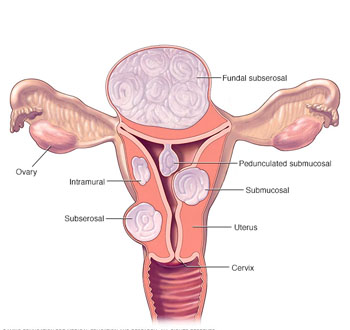Fibroid
Fibroids (also known as Leiomyomas/Myomas/Uterine Myomas/Fibromas) are abnormal growths that develop in or on a woman’s uterus. Sometimes these tumors become quite large and cause severe abdominal pain and heavy periods. In other cases, they cause no signs or symptoms at all. The growths are typically benign, or noncancerous. The cause of fibroids is unknown.
What are the different types of fibroids?
The type of fibroid a woman develops depends on its location in or on the uterus.
- Intramural fibroids: Intramural fibroids are the most common type of fibroid. These types appear within the muscular wall of the uterus. Intramural fibroids may grow larger and can stretch your womb and causes heavy bleeding and pain.
- Subserosal fibroids: Subserosal fibroids form on the outside of your uterus, which is called the serosa. They may grow large enough to make your womb appear bigger on one side.
- Pedunculated fibroids: Subserosal tumors can develop a stem, a slender base that supports the tumor. When they do, they’re known as pedunculated fibroids.
- Submucosal fibroids: These types of tumors develop in the middle muscle layer, or myometrium, of your uterus. Submucosal tumors aren’t as common as the other types.
What causes fibroids?
It’s unclear why fibroids develop, but several factors may influence their formation.
The type of fibroid a woman develops depends on its location in or on the uterus.
- Hormones: Estrogen and progesterone are the hormones produced by the ovaries. They cause the uterine lining to regenerate during each menstrual cycle and may stimulate the growth of fibroids.
- Family history: Fibroids may run in the family. If your mother, sister, or grandmother has a history of this condition, you may develop it as well.
- Pregnancy: Pregnancy increases the production of estrogen and progesterone in your body. Fibroids may develop and grow rapidly while you’re pregnant.
What are the symptoms of fibroids?
Symptoms of fibroids may include:
- Heavy bleeding between or during your periods that includes blood clots
- Pain in the pelvis or lower back
- Increased menstrual cramping
- Increased urination
- Pain during intercourse
- Menstruation that lasts longer than usual
- Pressure or fullness in your lower abdomen
- Swelling or enlargement of the abdomen
How are fibroids treated?
Your doctor will develop a treatment plan based on your age, the size of your fibroids, and your overall health. You may receive a combination of treatments.


